
April 21, 2020 | Report
Today, companies operate in an environment characterized by trade disputes, rising protectionism, complex regulatory regimes, unprecedented technological change, and evolving consumer demand. With the global growth outlook remaining uncertain, there is a stronger need than ever for companies to look for new ways to grow and add value. Creating new and evolving old business models to drive innovation is one way companies can respond to new risks and opportunities.1
One of the ways companies can innovate is through sustainability. An embedded sustainability approach can have a positive impact on business performance. Eco-efficiency—the practice of using environmental resources more efficiently (e.g., reducing energy consumption, using less material, and producing less waste)—not only reduces environmental footprint but can deliver significant cost savings through cost avoidance. Redesigning products and services keeping in mind emerging trends can offer new growth opportunities. Sustainable innovation can also build brand equity by creating emotional connections and making consumers feel good about embracing sustainable brands. Companies that have effectively integrated sustainability into their innovation processes have framed the sustainability discussion around growth and returns. This framing has helped them create measurable value for all stakeholders. Scenario planning can help companies develop insights for the future and guide their strategy as they develop sustainable innovation goals.
Sustainable innovation is about integrating sustainability principles into the innovation process and can be broadly defined as innovation that realizes economic value and generates positive environmental and social impacts.2
Three steps to sustainable innovation Sustainable innovation is a long-term endeavor. Organizational leaders can help their company develop an effective and reliable pathway to sustainable innovation by taking the following steps.


1 Charles Mitchell et al., C-Suite Challenge™ 2020: Risks, Opportunities, and Hot-Button Issues, The Conference Board, January 2020: 29.
2 Jens Horbach, ed., Indicator Systems for Sustainable Innovation (Sustainability and Innovation), (Springer, 2005).
January 21, 2025 | Quick Take
December 12, 2024 | Newsletters & Alerts
